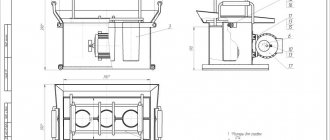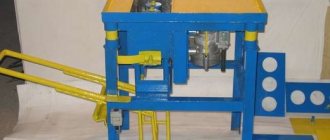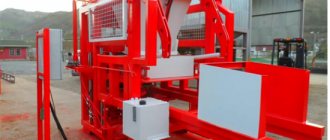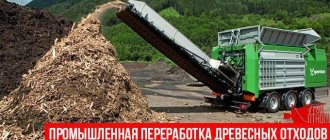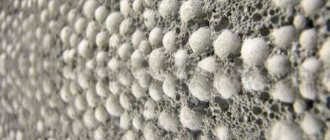The production of cinder blocks is an attractive type of business due to the simplicity of the technology and the low threshold for entry. Cinder block is a building material that is made using the vibrocompression method. To open this type of activity, it is enough to find a raw material base and purchase a cinder block machine.
How to make a cinder block machine
First, let's decide what goals we set for ourselves. If we need to build a small utility room, a barn, a summer kitchen or a temporary shed, this is one thing. In the same case, if we are going to sell cinder blocks, then the approach to its production should be completely different. Firstly, mass production of cinder blocks requires stability of the recipe, otherwise it will be simply impossible to produce high-quality cinder blocks. Secondly, the machine for making cinder blocks with your own hands, the drawings of which we have given right here, is not intended for large-scale production for obvious reasons.
The reliability and performance of a machine assembled from just about anything cannot be compared with a machine made in production conditions, where there is at least a hint of a quality guarantee. However, making a couple of hundred cinder blocks is not prohibited for anyone yet, so we present drawings with dimensions for a vibrating machine.
Homemade product
In addition to what we described earlier, you can make a homemade machine for cinder blocks, only this will require experience in welding and “friendship” with connecting the device to the network.
It cannot be said that this process (even taking into account your experience, if any) can be called easy, but we will still try to help:
- First , find a drawing of a cinder block machine on the Internet.
- Secondly , purchase all the materials, mainly metal sheets, metal tubes and wires. Don’t forget about the vibrator motor, which is freely sold in stores.
- Thirdly , decide on the size of future blocks.
For the work you will need a welding machine, an electric grinder and metal scissors, and, of course, instructions for use.
Do-it-yourself cinder block manufacturing technology
You can make a cinder block in a chicken coop, depending on what quality requirements you place on it. The general principles and technology for making cinder blocks are no different from industrial ones. Cinder block has standard sizes, shape and characteristics. We can achieve the shape ourselves, depending on the level of skill and degree of proficiency in welding, lathe, grinder and basic metalwork tools.
Be that as it may, the cinder block should measure 39x19x188 and have three holes in the body. These are linear characteristics only. If we talk about physical and technical issues, there is no guarantee that a garage cinder block will meet the standards. In any case, it will be different from the industrial one, for better or for worse.
To make a mixture for cinder block, the following materials are used:
- Slag.
- Sand.
- Cement.
- Modifying additives.
The correct cinder block can only be obtained using the vibration pressing method, which is worth familiarizing yourself with in more detail.
General recommendations and requirements
Cinder block dimensions
Cinder block for interior partitions
The dimensions of the cinder block are standardized - 188 x 190 x 390 mm. Each block has holes. Usually there are 3 of them. For the manufacture of building elements, a mixture of cement of a grade not lower than M400, blast furnace slag and coarse sand is used. Additional fillers and plasticizers are often added.
You can make blocks either manually using molds or using equipment with a vibrocompression function.
On average, one bag of cement is enough to make 36 blocks. The savings are obvious.
The cinder block must have the correct geometry. Even small irregularities will lead to deterioration in the quality of the masonry. To get even blocks, the molds need to be filled not just to the brim, but with a slight mound, because... During vibration, the concrete will shake slightly and settle.
Prices for different types of building blocks
Building blocks
What is a vibropress
Roughly speaking, a vibropress is a powerful table, the tabletop of which is suspended on springs or in another way. The vibration of the tabletop occurs due to a shift in the center of gravity in the eccentric, which is attached to the output shaft of the electric motor.
There are several types of suspension of a vibrating plate - spring suspension, on rubber cushions, or cables. A strong frame must stand securely and steadily on the ground while the vibrating plate compacts the cinder concrete mixture. In industrially manufactured machines, a balancer with a shifted center of gravity is installed directly under the vibrating plate and is rigidly attached to it. Homemade vibrating tables use different balancer drive schemes, but basically it is a belt drive, and this design has the reliability and quality of cinder block manufacturing.
Cinder blocks in molds
An alternative option is the production of building blocks without the use of vibration equipment. This will require forms of the required geometry and dimensions. They are rectangular boxes with side walls and a bottom. It is preferable to make molds consisting of two or three blocks - this will save material.
The solution poured into the mold is made plastic, which will prevent the formation of voids. When making hollow blocks, any suitable material, for example, glass bottles, is used as a void former. Having filled the form with the solution, it is compacted and left for a day or two. The removed block must stand for a month, after which it can be used for masonry work.
How to make a matrix with your own hands
The mold for making a cinder block is the most important thing in the process and the most important thing in the configuration of the machine. Without the correct shape, the whole point of making a cinder block yourself becomes a useless circle of Skillful Hands. The more irregularities and voids there are in the cinder block, the longer the wall will take to build, and the poorer the quality of the masonry will be. During the manufacturing process on a vibrating table, slag concrete tends to shrink, and this is quite natural, since the whole point of the vibrating table is to compact the solution as much as possible, driving all the air out of it.
If the matrix does not take this into account, the cinder blocks will be of different sizes, and it will be very difficult to make normal masonry from them. Therefore, professional machines also use a press to quickly stabilize the mixture. The matrix drawings and the step-by-step process of its manufacture require no explanation. Everything is clearly visible in the photo, and by observing these dimensions, you will get the perfect cinder block.
Pros and cons of making your own
There are several advantages to making your own cinder block machine:
- reducing the cost of the construction process from homemade blocks;
- the ability to make a machine to suit your needs;
- the ability to equip the equipment with the necessary containers at your request;
- the ability to make a new matrix if it becomes unusable.
There are also disadvantages, including the length of time it takes to manufacture the machine and possible mistakes made due to inexperience.
Composition of the mixture for cinder block
There is no single universal composition. The most important component of cinder concrete is cement. The slag can be any material:
- coal ash;
- blast furnace slag;
- expanded clay;
- granulated slag;
- boiler slag;
- processed sawdust.
As well as a wide variety of mixtures of these slags. As a rule, the cement used is M400 grade, and sifted quartz sand is preferable. It is mandatory to add plasticizers to the solution, modifying additives that change the properties of slag concrete depending on specific circumstances. It is recommended to follow the following mixing proportions:
- slag - 7 parts;
- cement M400 - 1.5 parts;
- sand - 2 parts;
- water - as needed, but no more than 3 parts.
As you can see, making a cinder block with your own hands is not so simple, but if you try and show patience and skill, everything will definitely work out.
Making cinder blocks at home
Ready-made equipment for making building blocks is quite expensive. The purchase of factory vibrating machines is justified only when carrying out construction work carried out in large volumes. In private construction, it is preferable to rent such equipment, but the option of self-production cannot be ignored.
It is the cinder block that is the most profitable material for construction on your site, because in this case the process is fast, economical and reliable
Equipment for the production of foam blocks
A machine for producing foam blocks at home is a pressure unit.
Let's look at the 6 main reasons why you need to choose this particular unit:
- Unlike the classic foam concrete production scheme, in the installation the entire process is carried out under pressure. Therefore, when unloading the solution, the pores in it are much larger, which in turn will make the blocks lighter;
- Using a conventional pressure plant, you can easily produce foam blocks and foam concrete for various needs:
- Foam blocks of various sizes and configurations, which are suitable for the construction of low-rise buildings;
- Foam concrete mixture used to fill lightweight brickwork (for insulation and sound insulation);
- Small blocks and slabs that are used for internal and external wall insulation.
- You can produce foam blocks and foam concrete even in a small room or in the open air - the installation itself occupies an area of less than 1 m²;
- Using a pressure unit, you can significantly save on hired labor. You will not need people to supervise the operation of the foam generator;
- Even a child can be taught how to operate a pressure unit - with the help of this unit, producing foam blocks has become very simple;
- The production of foam blocks and concrete using a pressure setting is not only a cheaper way to build a house, but also an opportunity to earn good money.
Lifting mechanism
Ready homemade machine
Typically, the design of a cinder block machine, made by hand according to drawings, provides for the presence of a special mechanism that will allow you to easily and quickly remove finished products from the machine. There are a lot of designs for such a device, since each master creates a device for producing such material for himself, using his own available materials and personal preferences.
The simplest option is to weld ordinary handles to the block mold, by pulling which, the almost finished building material can be removed from its shape. Of course, you can come up with a mechanism that is a little more complicated and easier to use.
Therefore, to manufacture a suitable lifting mechanism, you should study existing models of such equipment - both home-made machines and factory ones, and only after that begin to implement your own idea. In this case, you can make the most correct decision by choosing the optimal design for yourself.
Thus, using the information provided, anyone can make a machine for producing cinder blocks of a standard or their own design with their own hands. But to obtain the highest quality material, it must be based on a reliable and well-made form, as well as a special installation that will create vibrations.
Making a more complex machine
Drawing of a machine with a vibration and lifting mechanism
A more complex design of the machine, on which it will be possible to produce cinder blocks, additionally has a vibration mechanism, as well as a device for removing finished blocks from the cinder block mechanism.
It should be noted that this type of building material comes in three main types:
- solid concrete block without voids;
- blocks with voids, the volume of which is no more than a third of the volume of the entire product;
- blocks whose voids make up 40% of the total volume.
Such parameters must be taken into account when creating drawings for making such a machine yourself.
The most popular material of this type is a block with 30% voids. The drawings and design of a homemade machine for the production of just such blocks will be discussed further.
Competition and demand in the wall block market
Speaking about the cinder block production business, it is necessary to take into account that there are a large number of varieties of wall blocks on the market and they all compete with each other for the customer. The most common types of wall blocks include: foam concrete blocks, sand blocks made by volumetric vibrocompression, heat blocks, polystyrene concrete blocks, expanded clay concrete, wood concrete, ceramic block, thermally efficient Balaev blocks.
In addition to this, there are several more effective technologies for the construction of buildings and structures, such as wooden construction, frame construction and others.
There is fierce competition in this market; the choice of material for construction is difficult for the customer. We will not consider the comparative characteristics of all these materials from the point of view of effectiveness; similar studies can be found without difficulty.
However, with all the variety of choices, according to all the studies, it turns out that there is no cheaper material for construction. Some experts question the environmental characteristics of cinder block for the construction of residential buildings, but for the construction of outbuildings, cinder block looks very beneficial.
Let’s first evaluate how competitive cinder block is among comparable building materials. To assess the demand for cinder blocks, we will use Yandex keyword statistics. There is a special service for this. We will analyze the number of requests for the following search phrases: “buy cinder block”; “buy aerated concrete blocks” and “buy bricks”. Such requests, as a rule, are made by small construction companies and individuals carrying out construction, that is, direct consumers.
For the request “buy cinder block,” Yandex statistics indicate approximately 14 thousand requests per month. These statistics also include relevant queries, for example, “buy cinder block price” or “where to buy cinder blocks.” By region, the leader in requests is the Ural Federal District, the Central Federal District and the Siberian Federal District. Yandex Statistics, to assess demand, provides another indicator - “Regional popularity”. An indicator of regional popularity of a query above 100% characterizes the increased interest of users in a given region in the query. According to the “Regional popularity” indicator, the request “buy cinder block” in the Ural Federal District is 216%. That is, interest in these products has increased.
For comparison, Moscow carries out three times fewer requests for this keyword, and regional popularity is only 35%. This suggests that the main competitive advantage of cinder block, price, is most in demand in regions with a lower standard of living.
Let’s look at similar statistics for the key query “buy aerated concrete blocks.” For this request, as well as for relevant ones, for example, “aerated concrete block price”, the number of requests is about 14 thousand per month. Moscow and the Central Federal District are confidently leading in terms of the number of requests.
For the request “buy a brick,” Yandex statistics indicate more than 200 thousand requests per month. The request “buy facing bricks” is also popular in this block, with a share of almost 10% of all requests in this category. This ratio in requests is natural, since brick is the most common building material.
We conclude that the demand for cinder blocks is, of course, an order of magnitude lower than for bricks, but it exists. Peak demand values occur in March, April, May, that is, at the beginning of the construction season. During these months, the number of requests is more than 20 thousand requests per month. Statistics show that there is strong demand for cinder blocks in the Russian Federation. However, before deciding to open production, we recommend that you independently check the statistics on keywords for your region. We remind you once again that cinder blocks are sold near their production sites. This is done in order to reduce shipping costs. Check the number of searches for your city and region separately, this will help paint a more accurate picture of demand.
The Google search engine also has a similar service for analyzing keyword statistics. It would be optimal to estimate the number of queries in both search engines.
Vibrating table for the production of cinder blocks
This design differs from a brick making press in the way the mold is placed. In this case, the frame base is a metal tabletop (a sheet of metal with a thickness of 3 mm), which is installed on metal racks, to which springs (car or motorcycle) are welded on top. An electric motor (for example, from a broken or unused washing machine) is mounted directly on the tabletop, and a pulley with an eccentric is placed on the motor shaft, which is responsible for generating vibrations transmitted to the entire area.
The mold for pouring is placed on a vibrating table, otherwise the production process is similar to that discussed above. This design, despite its simplicity, is used less frequently, as it is characterized by a number of disadvantages:
- difficulty filling molds with solution;
- the need to provide a mechanism to facilitate lifting the form;
- significant labor costs associated with moving finished blocks.
Scope of application of cinder block
The main area of use of cinder blocks is the construction of buildings and structures. First of all, it is used for the construction of low-rise buildings, the construction of outbuildings, ventilation ducts and in landscape design.
The main competitor as a building material for cinder block is brick. Both materials have their pros and cons from the point of view of using them for the construction of buildings. The main advantage of using cinder block is its lower cost per square meter of the building being built, as well as the smaller amount of cement mixture required for masonry.
Types of building blocks
Brick is still the main material in the construction of high-rise buildings, but for low-rise construction it is cheaper to use other building materials. If you exclude wood, which is now expensive, the choice will still be varied. Modern wall materials are made from:
- foam concrete;
- slag concrete;
- aerated concrete;
- expanded clay concrete.
Block characteristics comparison table
As a filler for cinder blocks, a variety of and sometimes exotic materials are used, which are industrial waste: screenings, broken glass and bricks, sawdust, wood chips.
Let's first consider how expanded clay blocks and cinder blocks are made independently, as the most budget-friendly among all the above building materials.
